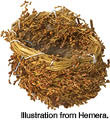

The basic premise of this regular column is that nature is full of
things that speak of an intelligence as being the basic cause of
what we see. The alternative is an attempt to find some series of
events  that might possibly
explain how what we see could develop by chance. A good example of
the difference in these two approaches is seen in the way in which
birds build their nests. Sharon Beals has written a book titled Nests: Fifty Nests and the Birds that
Built Them. She says there are basically six different
types of nests that birds build in the Midwestern part of the United
States:
that might possibly
explain how what we see could develop by chance. A good example of
the difference in these two approaches is seen in the way in which
birds build their nests. Sharon Beals has written a book titled Nests: Fifty Nests and the Birds that
Built Them. She says there are basically six different
types of nests that birds build in the Midwestern part of the United
States:
Cavity
nests: Naturally excavated trees. This includes
woodpeckers, wrens, chickadees, titmice, and bluebirds.
Cup nests: Small cups usually placed in trees or bushes
made of spider silk, plant down, lichen, moss, and plant fibers.
Some cup nests are so tightly woven they can hold rainwater.
Hummingbirds, phoebes, goldfinches, and vireos make this kind of
nest.
Pendant nests: Elaborately woven pouches hung on the ends
of tree branches. The main users of this style in our area are
orioles.
Platform nests: Massive platforms of sticks lined with
shredded bark or leaves. Herons, eagles, osprey, and hawks
construct these huge nests that can be nine feet across, 20 feet
deep and weigh several tons.
Scrape nests: A depression is scraped out and then lined
with down, grass, or leaves. Ducks, killdeer, shorebirds, and game
birds use this style of nest.
Saucer nests: This is a jumble of sticks and plant
material piled into a loose saucer shape. “Mourning dove nests are
often so flimsy the eggs can be seen from below!” Chimney swifts
use saliva to cement their saucer to the inside of a chimney or
hollow tree.
When these birds are raised in captivity, they still use the same
nest type as their parents even if they never saw a nest or their
own parents. It is clear this is programmed into their genes and is
not a learned behavior. Because not all birds use the same style, a
variety of nest sites is always available and materials are not
depleted. The method by which the genetic programming takes place is
an interesting question, but computers need to be programmed by an
intelligence, and we would suggest that an intelligence programmed
not only birds to build good nests, but also has given all animals a
way to survive in a complex world.
Source: Fernwood Notes,
Fall 2011, www.fernwoodbotanical.org.
Back to Contents Does
God Exist?, MarApr12.



 that might possibly
explain how what we see could develop by chance. A good example of
the difference in these two approaches is seen in the way in which
birds build their nests. Sharon Beals has written a book titled Nests: Fifty Nests and the Birds that
Built Them. She says there are basically six different
types of nests that birds build in the Midwestern part of the United
States:
that might possibly
explain how what we see could develop by chance. A good example of
the difference in these two approaches is seen in the way in which
birds build their nests. Sharon Beals has written a book titled Nests: Fifty Nests and the Birds that
Built Them. She says there are basically six different
types of nests that birds build in the Midwestern part of the United
States: